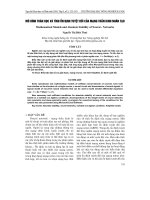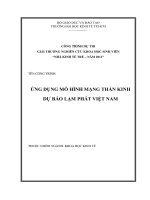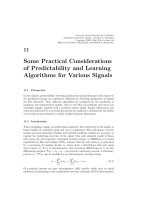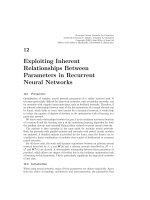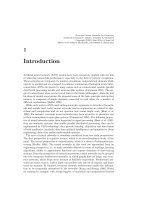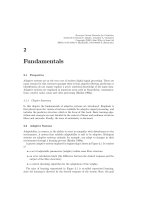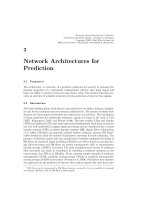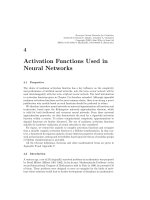Mạng thần kinh thường xuyên cho dự đoán P11
Bạn đang xem bản rút gọn của tài liệu. Xem và tải ngay bản đầy đủ của tài liệu tại đây (1.1 MB, 28 trang )
Recurrent Neural Networks for Prediction
Authored by Danilo P. Mandic, Jonathon A. Chambers
Copyright
c
2001 John Wiley & Sons Ltd
ISBNs: 0-471-49517-4 (Hardback); 0-470-84535-X (Electronic)
11
Some Practical Considerations
of Predictability and Learning
Algorithms for Various Signals
11.1 Perspective
In this chapter, predictability, detecting nonlinearity and performance with respect to
the prediction horizon are considered. Methods for detecting nonlinearity of signals
are first discussed. Then, different algorithms are compared for the prediction of
nonlinear and nonstationary signals, such as real NO
2
air pollutant and heart rate
variability signals, together with a synthetic chaotic signal. Finally, bifurcations and
attractors generated by a recurrent perceptron are analysed to demonstrate the ability
of recurrent neural networks to model complex physical phenomena.
11.2 Introduction
When modelling a signal, an initial linear analysis is first performed on the signal, as
linear models are relatively quick and easy to implement. The performance of these
models can then determine whether more flexible nonlinear models are necessary to
capture the underlying structure of the signal. One such standard model of linear
time series, the auto-regressive integrated moving average, or ARIMA(p, d, q) model
popularised by Box and Jenkins (1976), assumes that the time series x
k
is generated
by a succession of ‘random shocks’
k
, drawn from a distribution with zero mean
and variance σ
2
.Ifx
k
is non-stationary, then successive differencing of x
k
via the
differencing operator, ∇x
k
= x
k
−x
k−1
can provide a stationary process. A stationary
process z
k
= ∇
d
x
k
can be modelled as an autoregressive moving average
z
k
=
p
i=1
a
i
z
k−i
+
q
i=1
b
i
k−i
+
k
. (11.1)
Of particular interest are pure autoregressive (AR) models, which have an easily
understood relationship to the nonlinearity detection technique of DVS (deterministic
172 INTRODUCTION
0 500 1000 1500 2000 2500 3000
0
20
40
60
80
100
120
Time scale in hours
Measurements of NO
2
level
(a) The raw NO
2
time series
Figure 11.1 The NO
2
time series and its autocorrelation function
versus stochastic) plots. Also, an ARMA(p, q) process can be accurately represented
as a pure AR(p
) process, where p
p + d (Brockwell and Davis 1991). Penalised
likelihood methods such as AIC or BIC (Box and Jenkins 1976) exist for choosing
the order of the autoregressive model to be fitted to the data; or the point where the
autocorrelation function (ACF) essentially vanishes for all subsequent lags can also
be used. The autocorrelation function for a wide-sense stationary time series x
k
at lag
h gives the correlation between x
k
and x
k+h
; clearly, a non-zero value for the ACF
at a lag h suggests that for modelling purposes at least the previous h lags should be
used (p h).
For instance, Figure 11.1 shows a raw NO
2
signal and its autocorrelation function
(ACF) for lags of up to 40; the ACF does not vanish with lag and hence a high-order
AR model is necessary to model the signal. Note the peak in the ACF at a lag of 24
hours and the rise to a smaller peak at a lag of 48 hours. This is evidence of seasonal
behaviour, that is, the measurement at a given time of day is likely to be related to
the measurement taken at the same time on a different day. The issue of seasonal
time series is dealt with in Appendix J.
SOME PRACTICAL CONSIDERATIONS OF PREDICTABILITY 173
0 10203040
0.0 0.2 0.4 0.6 0.8 1.0
Lag
ACF
Series NO2
(b) The ACF of the NO
2
series
Figure 11.1 Cont.
11.2.1 Detecting Nonlinearity in Signals
Before deciding whether to use a linear or nonlinear model of a process, it is impor-
tant to check whether the signal itself is linear or nonlinear. Various techniques exist
for detecting nonlinearity in time series. Detecting nonlinearity is important because
the existence of nonlinear structure in the series opens the possibility of highly accu-
rate short-term predictions. This is not true for series which are largely stochastic
in nature. Following the approach from Theiler et al. (1993), to gauge the efficacy
of the techniques for detecting nonlinearity, a surrogate dataset is simulated from
a high-order autoregressive model fit to the original series. Two main methods to
achieve this exist, the first involves fitting a finite-order ARMA(p, q) model (we use
a high-order AR(p) model to fit the data). The model coefficients are then used to
generate the surrogate series, with the surrogate residuals
k
taken as random permu-
tations of the residuals from the original series. The second method involves taking a
Fourier transform of the series. The phases at each frequency are replaced randomly
from the uniform (0, 2π) distribution while keeping the magnitude of each frequency
the same as for the original series. The surrogate series is then obtained by taking
the inverse Fourier transform. This series will have approximately the same autocor-
174 OVERVIEW
relation function as the original series, with the approximation becoming exact in
the limit as N →∞. A discussion of the respective merits of the two methods of
generating surrogate data is given in Theiler et al. (1993), the method used here is
the former. Evidence of nonlinearity from any method of detection is negated if the
method gives a similar result when applied to the surrogate series, which is known to
be linear (Theiler et al. 1993).
11.3 Overview
This chapter deals with some practical issues when performing prediction of non-
linear and nonstationary signals. Techniques for detecting nonlinearity and chaotic
behaviour of signals are first introduced and a detailed analysis is provided for the
NO
2
air pollutant measurements taken at hourly intervals from the Leeds meteo sta-
tion, UK. Various linear and nonlinear algorithms are compared for prediction of air
pollutants, heart rate variability and chaotic signals. The chapter concludes with an
insight into the capability of recurrent neural networks to generate and model complex
nonlinear behaviour such as chaos.
11.4 Measuring the Quality of Prediction and Detecting Nonlinearity
within a Signal
Existence and/or discovery of an attractor in the phase space demonstrates whether
the system is deterministic, purely stochastic or contains elements of both. To recon-
struct the attractor examine plots in the m-dimensional space of [x
k
,x
k−τ
,...,
x
k−(m−1)τ
]
T
. It is critically important for the dimension of the space, m, in which
the attractor resides, to be large enough to ‘untangle’ the attractor. This is known as
the embedding dimension (Takens 1981). The value of τ, the lag time or lag spacing,
is also important, particularly with noise present. The first inflection point of the
autocorrelation function is a possible starting value for τ (Beule et al. 1999). Alter-
natively, if the series is known to be sampled coarsely, the value of τ can be taken as
unity (Casdagli and Weigend 1993). A famous example of an attractor is given by the
Lorenz equations (Lorenz 1963)
˙x = σ(y − x),
˙y = rx − y − xz,
˙z = xy − bz,
(11.2)
where σ, r and b>0 are parameters of the system of equations. In Lorenz (1963) these
equations were studied for the case σ = 10, b =
8
3
and r = 28. A Lorenz attractor is
shown in Figure 11.13(a). The discovery of an attractor for an air pollution time series
would demonstrate chaotic behaviour; unfortunately, the presence of noise makes such
a discovery unlikely. More robust techniques are necessary to detect the existence of
deterministic structure in the presence of substantial noise.
SOME PRACTICAL CONSIDERATIONS OF PREDICTABILITY 175
11.4.1 Deterministic Versus Stochastic Plots
Deterministic versus stochastic (DVS) plots (Casdagli and Weigend 1993) display the
(robust) prediction error E(n) for local linear models against the number of nearest
neighbours, n, used to fit the model, for a range of embedding dimensions m. The
data are separated into a test set and a training set, where the test set is the last
M elements of the series. For each element in the test set x
k
, its corresponding delay
vector in m-dimensional space
x(k)=[x
k−τ
,x
k−2τ
,...,x
k−mτ
]
T
(11.3)
is constructed. This delay vector is then examined against the set of all the delay
vectors constructed from the training set. From this set the n nearest neighbours are
defined to be the n delay vectors x(k
) which have the shortest Euclidean distance to
x(k). These n nearest neighbours x(k
) along with their corresponding target values
x
k
are used as the variables to fit a simple linear model. This model is then given
x(k) as an input which provides a prediction ˆx
k
for the target value x
k
, with a robust
prediction error of
|x
k
− ˆx
k
|. (11.4)
This procedure is repeated for all the test set, enabling calculation of the mean robust
prediction error,
E(n)=
1
M
x
k
∈T
|x
k
− ˆx
k
|, (11.5)
where T is the test set. If the optimal number of nearest neighbours n, taken to be the
value giving the lowest prediction error E(n), is at, or close to, the maximum possible
n, then globally linear models perform best and there is no indication of nonlinearity
in the signal. As this global linear model uses all possible length m vectors of the series,
it is equivalent to an AR model of order m when τ = 1. Small optimal n suggests
local linear models perform best, indicating nonlinearity and/or chaotic behaviour.
11.4.2 Variance Analysis of Delay Vectors
Closely related to DVS plots is the nonlinearity detection technique introduced in
Khalaf and Nakayama (1998). The general idea is not to fit models, linear or otherwise,
using the nearest neighbours of a delay vector, but rather to examine the variability
of the set of targets corresponding to groups of close (in the Euclidean distance sense)
delay vectors. For each observation x
k
, k m + 1 construct the group, Ω
k
, of nearest
neighbour delay vectors given by
Ω
k
= {x(k
):k
= k & d
kk
αA
x
}, (11.6)
where x(k
)={x
k
−1
,x
k
−2
,...,x
k
−m
}, d
kk
= x(k
) − x(k) is the Euclidean
distance, 0 <α 1,
A
x
=
1
N − m
N
k=m+1
|x
k
|
176 DETECTING NONLINEARITY WITHIN A SIGNAL
0 1000 2000 3000 4000 5000
0
50
100
150
200
250
Time in hours (k)
NO
2
level
0 1000 2000 3000 4000 5000
−150
−100
−50
0
50
100
Time in hours (k)
NO
2
level
0 1000 2000 3000 4000 5000
−200
−100
0
100
200
Time in hours (k)
NO
2
level
0 1000 2000 3000 4000 5000
−200
−100
0
100
200
Time in hours (k)
NO
2
level
Figure 11.2 Time series plots for NO
2
. Clockwise, starting from top left: raw, simulated,
simulated deseasonalised, deseasonalised
and N is the length of the time series. If the series is linear, then the similar patterns
x(k
) belonging to a group Ω
k
will map onto similar x
k
s. For nonlinear series, the
patterns x(k
) will not map onto similar x
k
s. This is measured by the variance σ
2
of
each group Ω
k
σ
2
k
=
1
|Ω
k
|
k
(x
k
− µ
k
)
2
, x(k
) ∈ Ω
k
.
The measure of nonlinearity is taken to be the mean of σ
2
k
over all the Ω
k
, denoted
σ
2
N
, normalised by dividing through by σ
2
x
, the variance of the entire time series
σ
2
=
σ
2
N
σ
2
x
.
The larger the value of
σ
2
the greater the suggestion of nonlinearity (Khalaf and
Nakayama 1998). A comparison with surrogate data is especially important with this
method to get evidence of nonlinearity.
11.4.3 Dynamical Properties of NO
2
Air Pollutant Time Series
The four time series generated from the NO
2
dataset are given in Figure 11.2, with
the deseasonalised series on the bottom and the simulated series on the right. The
SOME PRACTICAL CONSIDERATIONS OF PREDICTABILITY 177
0 10203040
0.0 0.2 0.4 0.6 0.8 1.0
Lag
ACF
Series NO2
0 10203040
0.0 0.2 0.4 0.6 0.8 1.0
Lag
ACF
Series NO2
0 10203040
−0.5 0.0 0.5 1.0
Lag
ACF
Series NO2
0 10203040
−0.5 0.0 0.5 1.0
Lag
ACF
Series NO2
Figure 11.3 ACF plots for NO
2
. Clockwise, starting from top left: raw, simulated,
simulated deseasonalised, deseasonalised
sine wave structure can clearly be seen in the raw (unaltered) time series (top left),
evidence confirming the relationship between NO
2
and temperature. Also note that
once an air pollutant series has been simulated or deseasonalised, the condition that
no readings can be below zero no longer holds. The respective ACF plots for the
NO
2
series are given in Figure 11.3. The raw and simulated ACFs (top) are virtually
identical – as should be the case, since the simulated time series is based on a linear
AR(45) fit to the raw data, the correlations for the first 45 lags should be the same.
Since generating the deseasonalised data involves application of the backshift operator,
the autocorrelations are much reduced, although a ‘mini-peak’ can still be seen at a
lag of 24 hours.
Nonlinearity detection in NO
2
signal
Figure 11.4 shows the two-dimensional attractor reconstruction for the NO
2
time
series after it has been passed through a linear filter to remove some of the noise
178 DETECTING NONLINEARITY WITHIN A SIGNAL
0 20406080
0 20406080
x
k
x
k+τ
NO
2
−40 −20 0 20
−40 −20 0 20
x
k
x
k+τ
NO
2
−6−4−20246
−6 −4 −2 0 2 4 6
x
k
x
k+τ
NO
2
−5 0 5
−5 0 5
x
k
x
k+τ
NO
2
Figure 11.4 Attractor reconstruction plots for NO
2
. Clockwise, starting from top left:
raw, simulated, simulated deseasonalised and deseasonalised
present. This graph shows little regularity and there is little to distinguish between
the raw and the simulated plots. If an attractor does exist, then it is in a higher-
dimensional space or is swamped by the random noise. The DVS plots for NO
2
are
given in Figure 11.5, the DVS analysis of a related air pollutant can be found in Foxall
et al. (2001). The optimal n (that is, the value of n corresponding to the minimum
of E(n)), is clearly less than the maximum of n for the raw data for each of the
embedding dimensions (m) examined. However, the difference is not great and the
minimum occurs quite close to the maximum n, so this only provides weak evidence
for nonlinearity. The DVS plot for the simulated series obtains the optimal error
measure at the maximum n, as is expected. The deseasonalised DVS plots follow
the same pattern, except that the evidence for nonlinearity is weaker, and the best
embedding dimension now is m = 6 rather than m = 2. Figure 11.6 shows the results
from analysing the variance of the delay vectors for the NO
2
series. The top two plots
show lesser variances for the raw series, strongly suggesting nonlinearity. However, for
SOME PRACTICAL CONSIDERATIONS OF PREDICTABILITY 179
5 50 500 5000
0.35
0.40
0.45
n
E(n)
m=2
m=4
m=6
m=8
m=10
NO
2
5 50 500 5000
0.40
0.45
0.50
n
E(n)
m=2
m=4
m=6
m=8
m=10
NO
2
5 50 500 5000
0.32
0.34
0.36
0.38
0.40
0.42
0.44
0.46
n
E(n)
m=2
m=4
m=6
m=8
m=10
NO
2
5 50 500 5000
0.36
0.38
0.40
0.42
0.44
0.46
0.48
n
E(n)
m=2
m=4
m=6
m=8
m=10
NO
2
Figure 11.5 DVS plots for NO
2
. Clockwise, starting from top left: raw, simulated,
simulated deseasonalised and deseasonalised
Table 11.1 Performance of gradient descent algorithms in prediction of the NO
2
time
series
Recurrent
NGD NNGD perceptron NLMS
Predicted gain (dB) 5.78 5.81 6.04 4.75
the deseasonalised series (bottom) the variances are roughly equal, and indeed greater
for higher embedding dimensions, suggesting that evidence for nonlinearity originated
from the seasonality of the data.
To support the analysis, experiments on prediction of this signal were performed.
The air pollution data represent hourly measurements of the concentration of nitro-
gen dioxide (NO
2
), over the period 1994–1997, provided by the Leeds meteo station.
180 DETECTING NONLINEARITY WITHIN A SIGNAL
0.2 0.4 0.6 0.8 1.0
0.0
0.2
0.4
0.6
0.8
1.0
α
m=2
m=4
m=6
m=8
m=10
σ
2
NO
2
0.2 0.4 0.6 0.8 1.0
0.0
0.2
0.4
0.6
0.8
1.0
α
m=2
m=4
m=6
m=8
m=10
σ
2
NO
2
0.2 0.4 0.6 0.8 1.0
0.0
0.2
0.4
0.6
0.8
1.0
α
m=2
m=4
m=6
m=8
m=10
σ
2
NO
2
0.2 0.4 0.6 0.8 1.0
0.0
0.2
0.4
0.6
0.8
1.0
α
m=2
m=4
m=6
m=8
m=10
σ
2
NO
2
Figure 11.6 Delay vector variance plots for NO
2
. Clockwise, starting from top left: raw,
simulated, simulated deseasonalised and deseasonalised
In the experiments the logistic function was chosen as the nonlinear activation func-
tion of a dynamical neuron (Figure 2.6). The quantitative performance measure was
the standard prediction gain, a logarithmic ratio between the expected signal and
error variances R
p
= 10 log(ˆσ
2
s
/ˆσ
2
e
). The slope of the nonlinear activation function
of the neuron β was set to be β = 4. The learning rate parameter η in the NGD
algorithm was set to be η =0.3 and the constant C in the NNGD algorithm was
set to be C =0.1. The order of the feedforward filter N was set to be N = 10.
For simplicity, a NARMA(3,1) recurrent perceptron was used as a recurrent network.
The summary of the performed experiments is given in Table 11.1. From Table 11.1,
the nonlinear algorithms perform better than the linear one, confirming the analysis
which detected nonlinearity in the signal. To further support the analysis given in
the DVS plots, Figure 11.7(a) shows prediction gains versus number of taps for linear
and nonlinear feedforward filters trained by the NGD, NNGD and NLMS algorithms,
whereas Figure 11.7(b) shows prediction performance of a recurrent perceptron (Fox-
SOME PRACTICAL CONSIDERATIONS OF PREDICTABILITY 181
all et al. 2001). Both the nonlinear filters trained by the NGD and NNGD algorithms
outperformed the linear filter trained by the NLMS algorithm. For the tap length up
to N = 10, the NNGD was outperforming the NGD; the worse performance of the
NNGD over the NGD for N>10 can be explained by the insufficient approximation
of the remainder of the Taylor series expansion within the derivation of the algorithm
for large N . The recurrent structure achieved better performance for a smaller number
of tap inputs than the standard feedforward structures.
11.5 Experiments on Heart Rate Variability
Information about heart rate variability (HRV) is extracted from the electrocardio-
gram (ECG). There are different approaches to the assessment of HRV from the
measured data, but most of them rely upon the so-called R–R intervals, i.e. distance
in time between two successive R waves in the HRV signal. Here, we use the R–R
intervals that originate from ECG obtained from two patients. The first patient (A)
was male, aged over 60, with a normal sinus rhythm, while patient (B) was also male,
aged over 60, who suffered a miocardial infarction. In order to examine predictability
of HRV signals, we use various gradient-descent-based neural adaptive filters.
11.5.1 Experimental Results
Figure 11.8(a) shows the HRV for patient A, while Figure 11.8(b) shows HRV for
patient B. Prediction was performed using a logistic activation function Φ of a dynam-
ical neuron with N = 10. The quantitative performance measure was the standard
prediction gain R
p
= 10 log(ˆσ
2
s
/ˆσ
2
e
). The slope of the nonlinear activation function of
the neuron β was set to be β = 4. Due to the saturation type logistic nonlinearity,
input data were prescaled to fit within the range of the neuron activation function.
Both the standard NGD and the data-reuse modifications of the NGD algorithm
were used. The number of data-reuse iterations L was set to be L = 10. The perfor-
mance comparison between the NGD algorithm and a data-reusing NGD algorithm
is shown in Figure 11.9. The plots show the prediction gain versus the tap length
and the prediction horizon (number of steps ahead in prediction). In all the cases
from Figure 11.9, the data-reusing algorithms outperformed the standard algorithms
for short-term prediction. The standard algorithms showed better prediction results
for long-term prediction. As expected, the performance deteriorates with the order of
prediction ahead. In the next experiment we compare the performance of a recurrent
perceptron trained with the fixed learning rate η =0.3 and a recurrent perceptron
trained by the NRTRL algorithm on prediction of the HRV signal. In the experi-
ment the MA and the AR part of the recurrent perceptron vary from 1 to 15, while
prediction horizon varies from 1 to 10. The results of the experiment are shown in Fig-
ures 11.10 and 11.11. From Figure 11.10, for a relatively large input line and feedback
tap delay lines, there is a saturation in performance. This confirms that the recur-
rent structure was able to capture the dynamics of the HRV signal. The prediction
performance deteriorates with the prediction step, and due to the recurrent nature
of the filter, the performance is not good for a NARMA recurrent perceptron with
